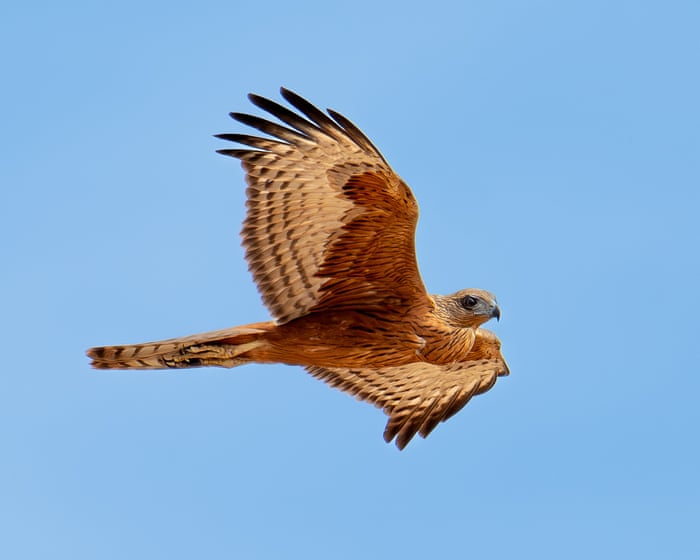The red goshawk builds its nest high in the tallest tree, often near a creek, and hunts below the forest canopy, pursuing fast-moving prey like rainbow lorikeets and snatching them from the air. As it accelerates, the deep, powerful beat of its meter-wide wings can be heard from the ground before it glides and turns silently, like a feathered fighter jet.
Yet this unique bird, found only in Australia, is vanishing from the landscape. “It has gone extinct across eastern Australia, right under our noses,” says Chris MacColl, a researcher at the University of Queensland and BirdLife Australia. “Until the 2000s, it was still frequently spotted in northern New South Wales and southeast Queensland, but since then, sightings have completely disappeared. It has fallen off the map.”
Although first described in 1801, the red goshawk was never common, and until recently, little was known about the habits of Australia’s rarest bird of prey. Most birdwatchers have never seen one.
Now, scientists like MacColl are racing to determine how many remain so they can refine conservation strategies. Dr. Richard Seaton, BirdLife Australia’s director of terrestrial birds, spent months searching for them in southeast Queensland in 2013, revisiting sites where they had been recorded just 15 years earlier. “I couldn’t find them anywhere, so we started a recovery team,” he says. “At the time, we didn’t know their home range, habitat needs, or even what they were doing or where they were going.”
Historically, the species ranged as far south as Sydney. In the late 18th century, convict artist Thomas Watling sketched one from a specimen nailed to a settler’s hut in Botany Bay. That drawing, now in Britain’s Natural History Museum, reached British ornithologist John Latham, who used it to formally describe the red goshawk in 1801.
In 2023, the Australian government upgraded the red goshawk’s status from vulnerable to endangered, signaling it is closer to extinction, and estimated only 1,300 mature birds remain in the wild. MacColl believes the actual number may be under 1,000.
Today, the bird’s breeding areas are confined to the tropical savannas of northern Australia, from the Kimberley in the west to Cape York in Queensland. “While that area is mostly intact, it has its own challenges,” says MacColl, who has studied the species for seven years. “I worry about climate change, especially the extreme heat and thermal risks for young birds, along with ongoing habitat loss from agriculture, logging, and mining.”
Satellite tracking has shown that some juveniles undertake a risky 1,500-kilometer journey south to central Australia for about eight months, possibly to learn hunting skills, before returning permanently to their coastal refuges.
The reason for the species’ rapid range collapse is unclear, but Seaton suspects habitat fragmentation is to blame. “They seek out the tallest trees in the tallest stands, and those aren’t as common anymore,” he explains.
Red goshawks are elusive, with vast home ranges—possibly up to 600 square kilometers—and were historically sparsely distributed along coasts and waterways. They are not noisy, and unlike most large birds that flee when humans approach, alerting observers, a red goshawk may remain still and unnoticed.The hawk “will just stare at you.”
BirdLife Australia researchers and Indigenous rangers are working together to spot red goshawks in Litchfield National Park. According to Seaton, there were only 10 known breeding pairs on the Australian mainland this year, with another 10 on the Tiwi Islands. Melville Island, the largest of the group, is now considered the red goshawk’s main stronghold.
BirdLife Australia is training Indigenous rangers and traditional owners in the north to identify the birds and monitor their nests. These nests, built from thick sticks on horizontal branches and about a meter wide, are checked to assess breeding success and improve estimates of the red goshawk population.
Chris Brogan, a Tiwi Islander and firefighter for Plantation Management Partners on Melville Island, is part of a team that observes the birds. They watch nest activity in 30-minute intervals.
“They’re beautiful, but they can be hard to spot because their colors blend in with the tree trunks,” he says. “When I first started, I thought they were common and everywhere. Now I realize they’re disappearing.”
MacColl first became fascinated with red goshawks about ten years ago when he saw a nest in western Cape York while working as an environmental scientist for Rio Tinto. “I’ve been totally obsessed ever since,” he admits.
Red goshawks belong to a genus with only one other known member: Papua New Guinea’s chestnut-shouldered goshawk. MacColl is impressed by their strength, noting that if a red goshawk picks up a stick from the forest floor, it can fly straight up 30 meters to its perch.
“There really is nothing like them,” MacColl says. “They aren’t closely related to any other bird of prey in Australia—they’re on their own branch of the evolutionary tree. To prevent their extinction, we’ll need a network of people and the best information to understand what they require.”
Frequently Asked Questions
Of course Here is a list of FAQs about Australias most endangered bird of prey framed as a silent crisis
BeginnerLevel Questions
1 What is Australias most endangered bird of prey
The Red Goshawk is currently considered Australias most endangered bird of prey
2 Why is it called a silent crisis
Its called a silent crisis because their population is declining so rapidly and quietly with little public awareness or action that they could disappear without most people even noticing
3 What does a Red Goshawk look like
They are large powerful hawks with striking reddishbrown or rufous plumage on their chest and wings and they have long legs and sharp talons
4 Where in Australia can you find them
They are found only in northern and eastern Australia primarily in a narrow band from the Kimberley in Western Australia through the Top End and down the Queensland coast to northern New South Wales
5 What do they eat
They are specialists that primarily hunt other birds from small parrots to large birds like cockatoos and ducks often catching them midair
6 Why should I care if one bird species disappears
Every species plays a unique role in the ecosystem Losing the Red Goshawk a top predator can disrupt the balance leading to overpopulation of their prey species and a less healthy environment overall
Advanced CauseFocused Questions
7 What are the main reasons the Red Goshawk is disappearing
The primary threats are habitat loss from land clearing for agriculture and development a reduction in their prey species and potentially the effects of climate change altering their specialized woodland habitat
8 How many Red Goshawks are estimated to be left
The population is critically low Recent estimates suggest there may be fewer than 1000 mature individuals left in the wild and the number is declining
9 Is climate change affecting them
Yes Climate change can increase the frequency and intensity of fires and droughts which degrade the open woodlands and forests they rely on for hunting and nesting
10 What is being done to protect them right now
Conservation efforts include monitoring known nesting sites protecting habitat through land acquisitions and agreements with landowners and ongoing research to better understand their ecology and threats




